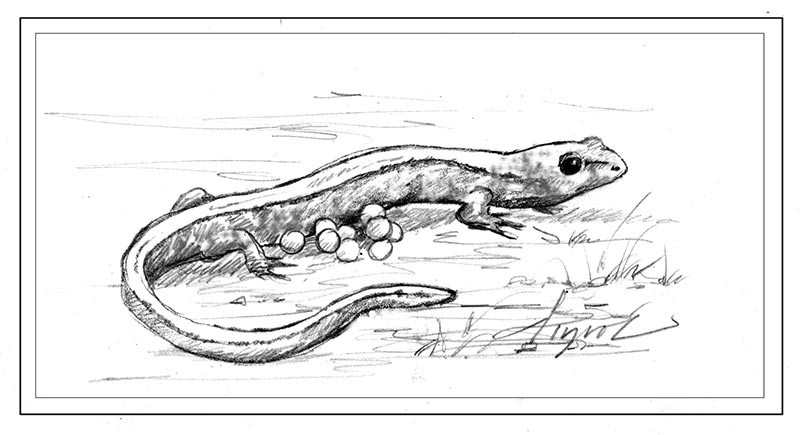
I once heard of a biologist with a clever party trick: regardless of where or when a given party was taking place, he claimed that he could produce a wild salamander in 15 minutes or less, and more often than not, he delivered. I suspect he never tried this at any New Year’s Eve parties in northern Vermont, where salamanders are wintering well underground, and where the ground itself is buried under several feet of fresh powder. At the same time, I’d wager that much of his success was due to a single species: the red-backed salamander (Plethodon cinereus).
This small, slender salamander (also known as a “redback”) has disproportionately small legs and is often, though not always, distinguished by a rust-red stripe running the length of its back and tail. Redbacks spend their lives under logs and in deep underground burrows, dining on earthworms, ants, mites, and other small, subterranean delicacies. The females demonstrate remarkable maternal devotion, aggressively defending their eggs against predators for the full month until the young hatch out – a display of parental care that is quite rare among amphibians.
What redbacks lack in size, they make up for in abundance. A landmark 1975 study at Hubbard Brook Experimental Forest in northern New Hampshire found that the biomass of red-backed salamanders – just that one species – was more than twice that of all the bird species in their study area combined. While you’re picking your jaw up off the floor, consider this: more recent research suggests that this figure may have been an underestimate, as redbacks spend more of their time in underground burrows than they do near the surface, which makes it difficult for us surface-dwelling humans to accurately measure their abundance. And they’re not just found in the deep woods: redbacks are common in backyard wood piles, suburban forests, and even urban parks.
In short, they’re everywhere. This makes them an ideal study organism for biologists interested in tracing the effects of climate change and land use on forest health.
Enter SPARCnet or, for the longwinded among us, the Salamander Population Adaptation Research Collaboration Network, a group of researchers and educators founded to dig deeper into the impacts of anthropogenic stressors on woodland amphibians.
At its core is an elegant study design – easily replicated, simple enough that 4th graders can use it to collect meaningful information, flexible enough to serve as a springboard for headier academic research – comprised of small wooden “coverboards” that appeal to redbacks as sources of shelter. There are 30 SPARCnet sites, from Virginia to Michigan to Ontario, including the one I manage at the Harris Center for Conservation Education in Hancock, New Hampshire. Each monitors a series of coverboards for salamanders in spring and fall, when redbacks are more likely to be active near the surface.
At some sites, for example at universities, researchers mark and measure each individual salamander in order to gain detailed data about salamander movements, longevity, and population density. At sites hosted by schools and nature centers, like ours, surveys simply involve lifting up each board and counting how many salamanders we find. Taken together over the long term, the two techniques may reveal how red-backed salamander populations cope with changing precipitation, temperature, and soil conditions stemming from climate change.
From an educator’s perspective, the SPARCnet surveys are a great opportunity. When we pause for a moment before turning over a coverboard, we feel a gentle rise of hopeful anticipation. If we’re lucky enough to turn over a board and find a salamander – or, as happened in a SPARCnet plot at the University of Richmond in Virginia, 11 of them! – there’s a thrill of connection and discovery, of seeing the unseen. We hold a small creature in our hands. We participate in the process of science. We begin to understand how it is that scientists know what they know, and we start to wonder our own questions about how the forest works. Perhaps most importantly, we open our eyes to the incredible biodiversity that lies hidden just beneath the surface of our everyday existence. We make the invisible visible.
How’s that for a party trick?

